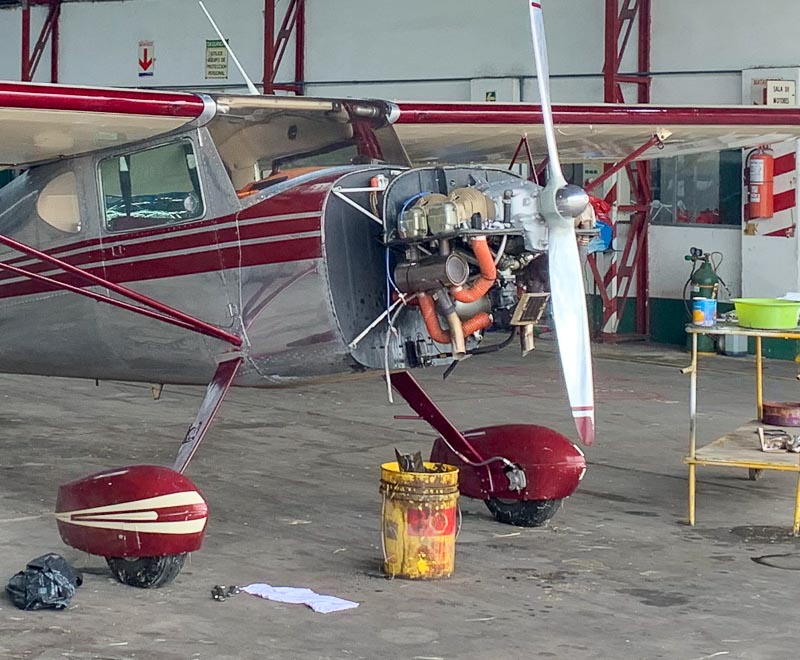It rains all night, but in the next morning, the sun shines brightly. Nice flying weather. Breakfast, check-out, same routine, every day. Gets boring. The hotel is close to the airport – good: no taxi needed.
I follow Juan’s security procedure and walk into the terminal, find the office of the Policia Securidad Aeronautica PSA and show the proof that I filled out and sent the departure declaration electronically. But the uniformed lady looks worried. Something is wrong. She makes phone calls, let me fill out a paper form, asks me to wait. It takes nearly an hour. Then I am allowed to go to the hangar and pull the 140 out. It is still a beautiful morning:
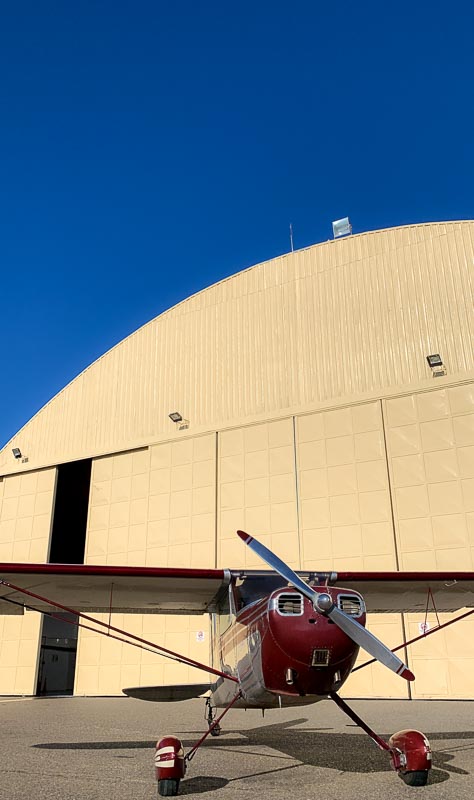
Turbulence has been forecasted, but it hit me nevertheless unexpected. Objects are tossed around. I use the co-pilot's seatbelt to secure my bag pack and the water bottle. On the leg to Macachin, ground speed is usually between 130 and 140 knots, which means I am enjoying a 50-knot tailwind. Peak ground speed, my record with the Cessna 140 so far, is 150 knots in level flight:
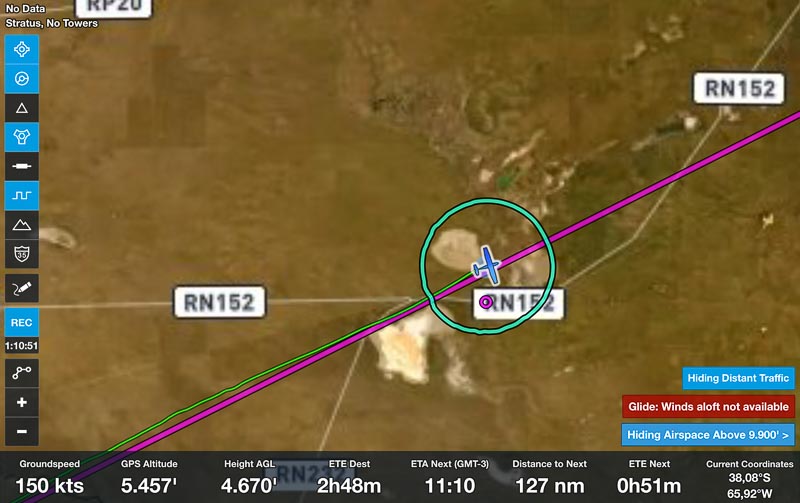
Even my followers in the N5581M WhatsApp group are astonished. Go 140! Go! Guido writes.
Below me, a barren desert. I see an oil refinery. Sometimes power lines and streets, but no cars. After an hour or so, vegetation slowly increases:
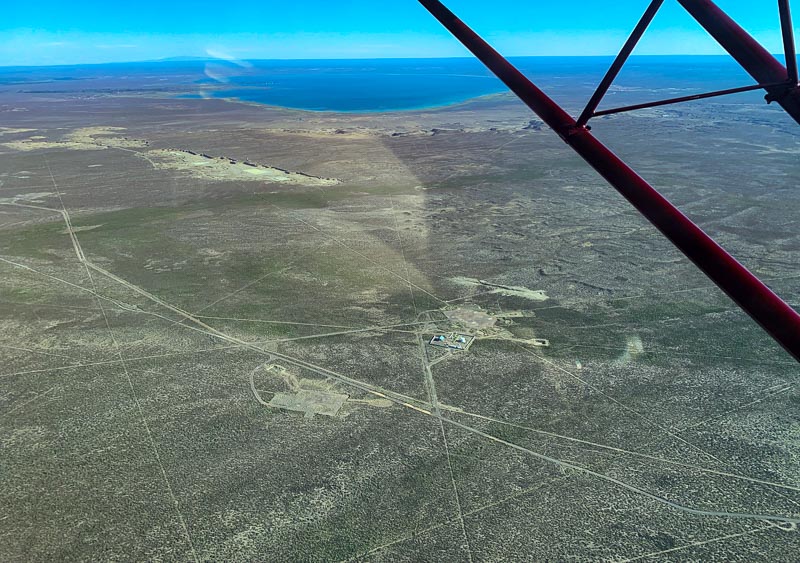
Still very few people. Salt lakes. Some protected, which means you need to fly at least 3000 ft above them:
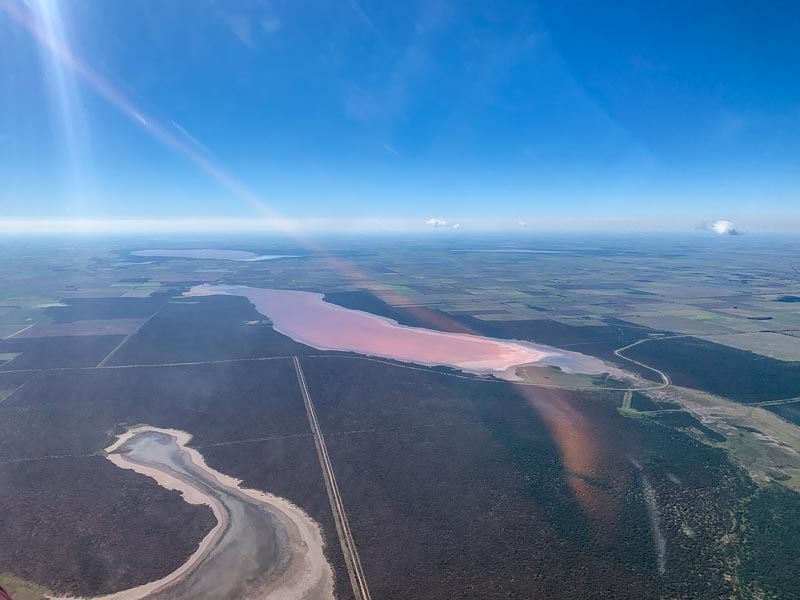
Well, I fly at FL 55, which is about 4.500 ft over the ground here. Due to the tail wind, flight time is only a bit over 2 hours, instead of the 4 hours it would have been yesterday with the head wind. I check in with Ezeiza Radio, but they do not offer any service. The air is as empty as the ground. Argentina is a huge country.
Macachin comes into view. A small grid of streets, enough buildings to call it a town. Gras runway, direction 18 / 36. But the wind blows with at least 15 knots from the west, directly cross. I try a 3-point. Usually, a main wheel landing is better in strong crosswind, but on grass the directional controllability is better. There is a large welcome committee. What did I do, to deserve this? I shake hands, look in friendly faces and try to memorize all the names. Impossible task. They ask me things, but I want to learn from them.
Horacio and one or two of the others are crop duster pilots. One of the big yellow crop dusters is parked next to my 140, another in a hangar.
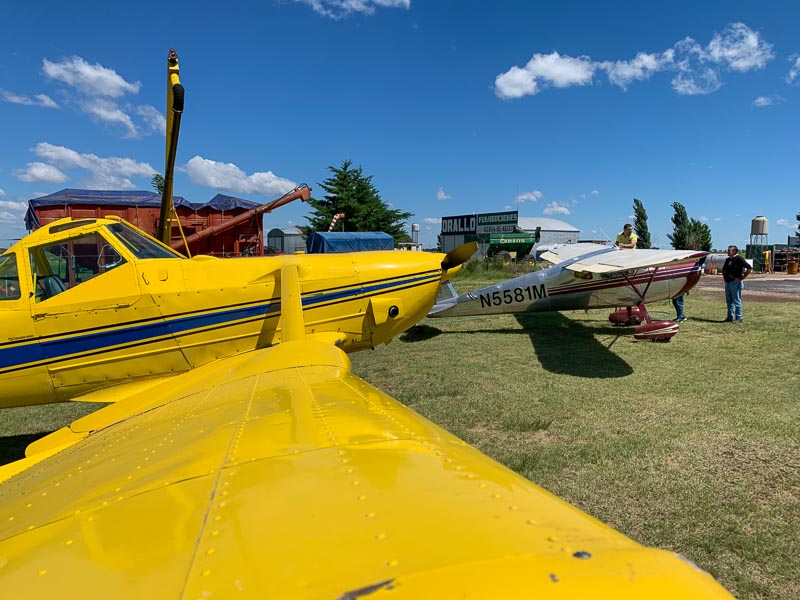
We crop duster pilots are low on the letter of society, Horacio moans. Even lower than the drug dealers. We destroy the environment, they say. But the people on earth need to eat. There are too many people. Impossible without pesticides.
How long are crop duster missions, I ask. Depends. 1.5 hours maybe? Then you refill pesticides and take off again. You are paid by the sprayed area. After 6 hours it gets dangerous. You fly very close to the ground. The brain plays tricks with you. You make mistakes. You see the power line and you avoid it several times, but then you hit it. Horacio shows me the reinforcements made against the power line enemy. Blades at the gear struts, supposed to cut the line. The cable from the cockpit to the top of the tail, is no ADF antennae, it is to deflect a hitting power line.
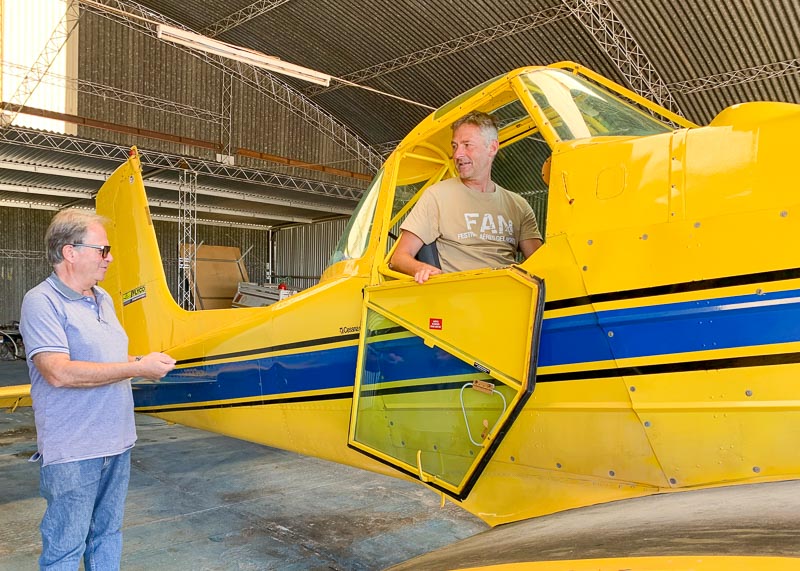
Horacio asks me, if I agree to an interview with a journalist. When I say yes, he hands me the phone and I am on air at a local radio station. My first live radio interview in Spanish. Fun. The club prepares a typical argentine assado for me. It starts with some bread, cheese and sausages as snacks to eat with your fingers or toothpicks, while the asador prepares the meat at the parilla. Traditionally, the parilla uses coal or wood, but in some clubs, they use a gas grill. Probably easier. People in Argentina, especially in the campo, don’t eat the lomo Argentina is famous for. They eat beef with more fat, e. g. ribeye or roastbeef. And they usually eat it well done, not medium, like most Europeans prefer. Side dishes are the exception. Meat alone is a complete meal. It is fantastic. We are having fun. After lunch, Fabian wants to do an interview with me for his Youtube channel. Of course, I agree, but I stumble even more, than during the radio interview.
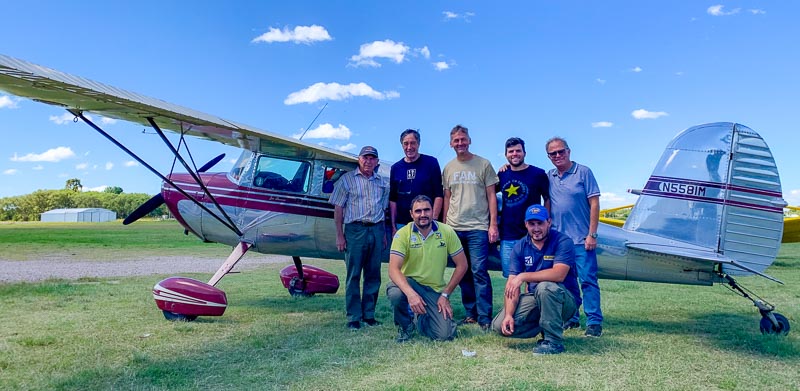
Refueling is done quickly and they do not allow me to pay. I am grateful and feel proud to be a part of this aviation community.
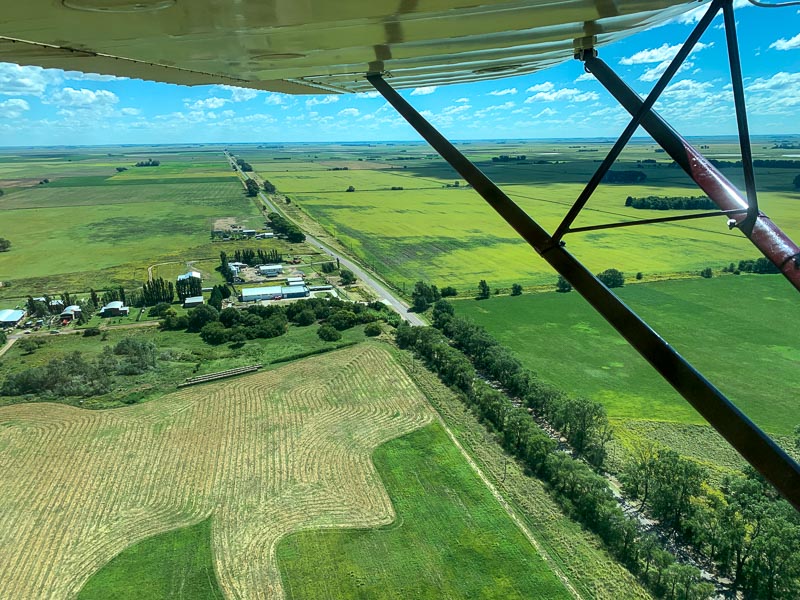
Ground speeds on my second flight today, from Macachin to Bolivar, are a bit lower. Only 110 to 120 knots. The land below me is green now. Brown spots, cows, appear on the green. I fly without a flight plan. For the first time, since N5581M flew within the United States. The airspace and the two airports are uncontrolled, so it is allowed, the friends in Macachin told me. Freedom. Fun. I spent more time in Macachin than planned, so I know that it would be a race against the sunset, if I would continue from Bolivar to Matanza. I decide, even before landing, to spend the night in Bolivar.
In Macachin it was gras, here it is a 1200 m paved runway:
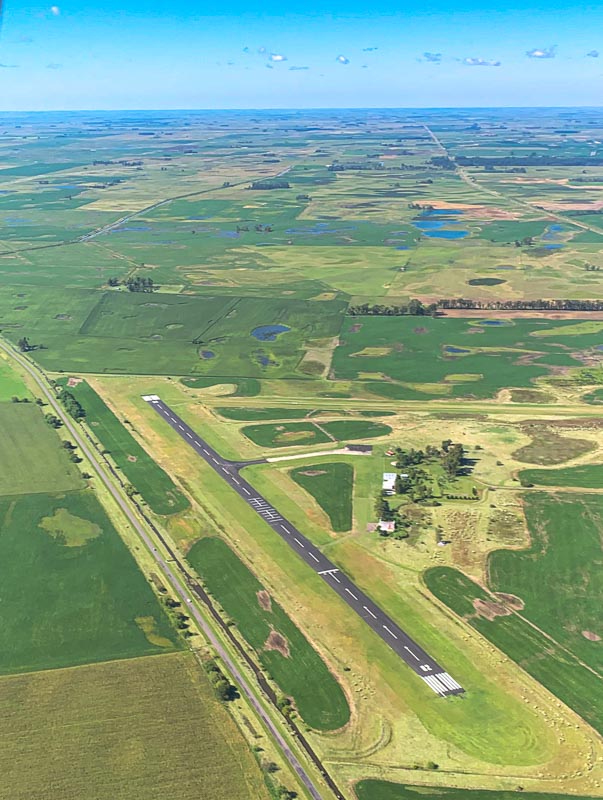
Who builds such a runway in the Pampa? And why? I taxi to the Aeroclub hangar.
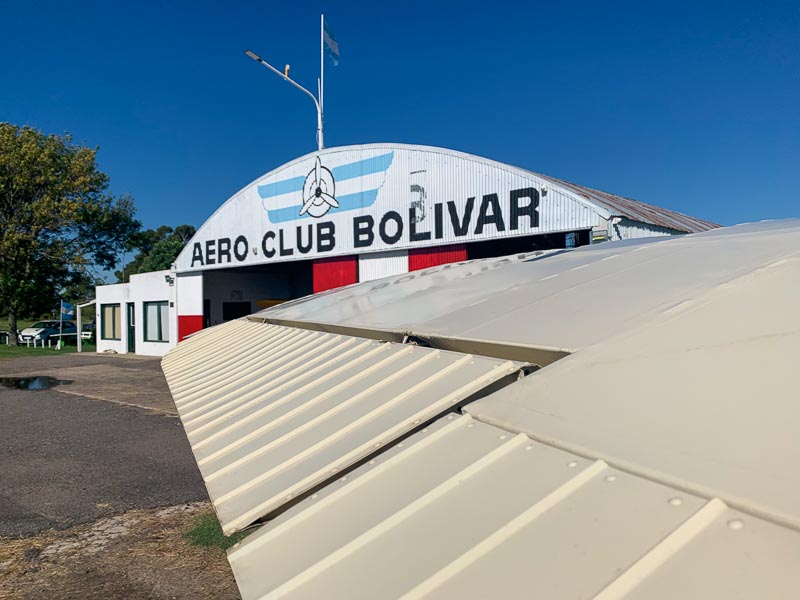
Gualberto and Luis are already waiting. Fueling starts immediately. They work as a team. It feels like a Formular 1 box stop – Argentine style. There is some problem with the pump, so the Avgas is first transferred into open buckets using what looks like a garden house. Gualberto then uses a ladder, places the bucket on my wing, opens the filler, inserts an Argentine style home made fuel filter and pours the fuel from the bucket into the funnel of the fuel filter. Within 5 minutes, my tanks are full again.
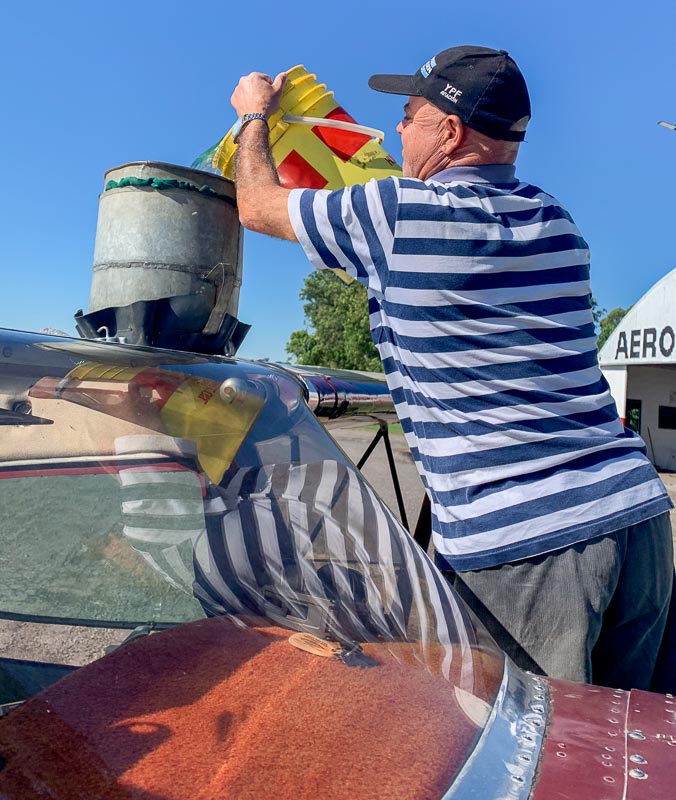
Then they welcome me. Again, a warm welcome. They make me feel at home. You don’t need a hotel, you can use the bunks here at the Aeroclub, Gualberto pointed out. Tonight, we make an asado, he adds. After a tee and some talk, he leaves me in my new home, his Aeroclub. By now, I have seen a few. There are similarities. They all have a parilla, a small kitchen and a table large enough for 20 or 30 people. Often, the same room is used for teaching too. A whiteboard. Charts, showing the area or piloting techniques, e. g. how to enter a traffic pattern, often sponsored by Piper or Chicul, the argentine company which produced Piper aircraft from the 1970s to the 1990:
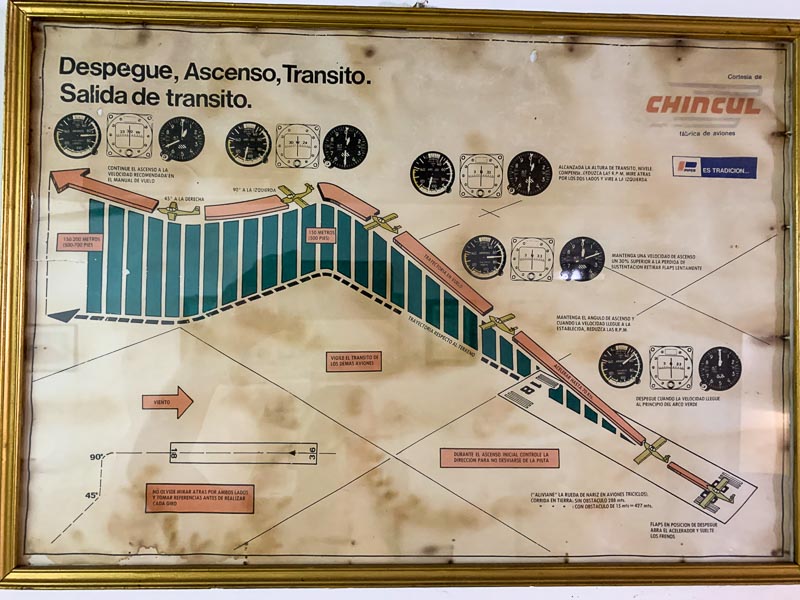
They fly a lot of Piper in Argentina, PA 28, PA 38 and – of course – the PA 18 Super Cub. The club has a yellow Cub in the hangar. With very basic instruments. Original. Avionics upgrades are rare in Argentina. They also have a Cessna 150. Gualberto comes back from shopping with enough meat for 10. A family appears. The 18-year-old girl Is a flight student and Gualberto her instructor. She pre-flights the Cessna and flies a few patterns with Gualberto. She is pre-solo. They return after 40 minutes. This is enough, declares Gualberto. I think the family stays for the asado, but they leave. The sun is setting, it is getting quiet, here in the campo. Lovely, I enjoy being here, until the first mosquitos’ sting.

Gualberto is mixing a green salad with some tomatoes, then he prepares the parilla. Here in Bolivar, they use a wood fire inside an old gasoline drum:

Indoors. Less mosquitos indoors. Gualberto speaks no English, forcing me to speak Spanish. After a beer, speaking Spanish is getting more difficult. The subjects we discuss get more complex too. Initially, I always say what I say to everybody, so I know what to say. But then, when we discuss complex matters like flying philosophies, aircraft accidents or the Ukraine crisis, I run out of words and can’t follow the arguments anymore. With another beer, it doesn’t matter. There is understanding, between men at least, without understanding. The meat is well done. Maybe a bit dark on one side.
Gualberto leaves the club house and I stretch myself on the bunk. Quit. Only the mosquitos can be heard. They keep me awake. Sometimes the dogs bark, but I don’t see anybody. There is nobody around, probably for a few hundred meters at least, if not kilometers.
When I wake up, I know I have only slept a few hours. The shower helps. It all needs a bit maintenance, but it works, I have nice hot water. Controlled airspace ahead, so I file a flight plan. Filing with Foreflight doesn’t work in Argentina, I only prepare it with Foreflight, airdrop it to my laptop, add a png signature to the ICAO form and email it to the next controlled airport. To fill the 60 minutes between filing and take off, Gualberto and I go for a little walk. He shows me a weather station with a lonely lady guarding it. Why don’t they offer a METAR if they have a meteorologist here in Bolivar, I ask. This is Argentina, he answers.
We walk on the runway. There is no traffic, so this is safe. Well, maybe. A snake is using the morning sun to warm up. We keep our distance. Gualberto shows me the runway edge lights. Some are broken. No money to repair them. Can the pilots switch them on? No, Gualberto says. No night flying possible in Bolivar.
It is time to say good-bye. I use the beautiful runway to practice some wheel landings, then I leave the pattern. Green fields. Cows. Haciendas. Some have private runways, some paved and used to fly to Buenos Aires:

Some unpaved, usually used for crop dusting:

My destination is Matanza, one of the many small airfields in the Buenos Aires metropolitan area. Buenos Aires is the capital of Argentina. Like many other capitals, e. g. Washington D.C., the center of Buenos Aires is not part of a province, it is a territory of its own, called CABA – Ciudad Autonoma de Buenos Aires. Its dimensions are easy to see on a map, a wide freeway goes around it. Matanza is just outside of CABA, about 20 minutes away from what they call the microcentro, but of course still in the metropolitan area, halfway to the international airport of Ezeiza. I contact Ezeiza Tower, open my flight plan and they let me fly through their control zone, avoiding the visual corridors used by those, who don’t want to talk to the Tower or don’t have a transponder. I know my way, have flown here before with rented aircraft, now I fly my own. Matanza has a special entry procedure. I land on the gras runway:
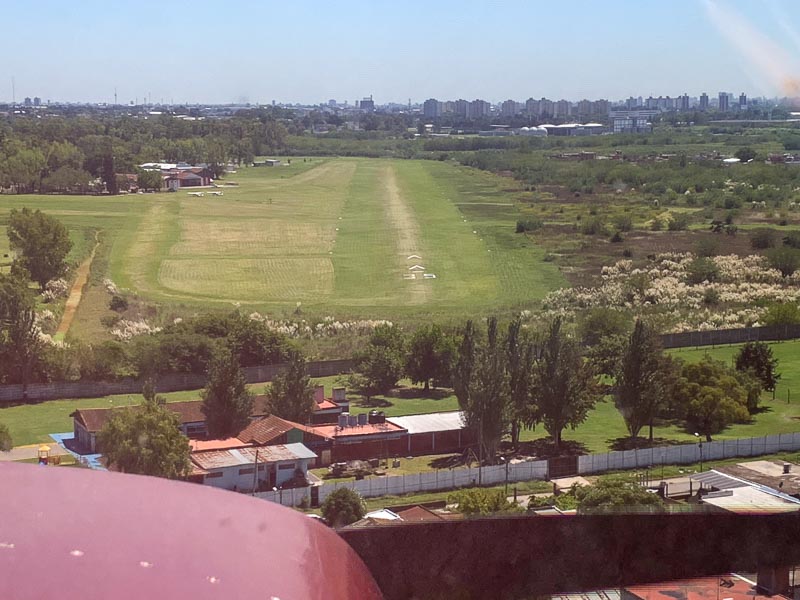
Lucho is already there to welcome me. Congratulations come in via WhatsApp. Argentina was the goal, after all.
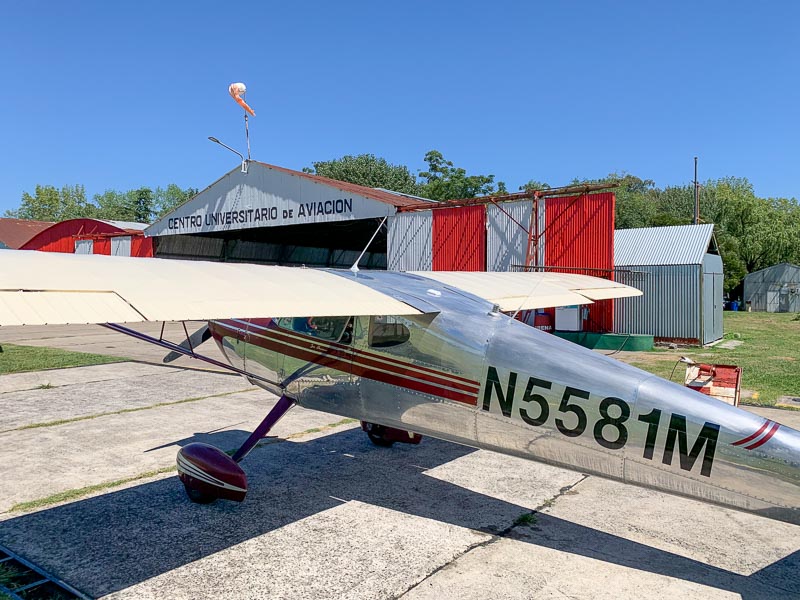
And now, I am here. Well, my ultimate destination has changed, it is now Uruguay. But who cares? I am happy to be home.
We offload the luggage and the gas cans and fly a few patterns in Matanza:

She flies beautifully, Lucho declares.
It is still before noon and my plan was to start working rightaway on the plane. N5581M needs some care and preventive maintenance, after the 30 hours tach time she got in the last 3 weeks. But I am tired. Having slept well in Bolivar. So, I call an Uber and let me drive to our second home, in the microcentro. In my own bed, I sleep like a stone.
Feeling much better today. Horacio joins me for breakfast. He brought a lot of tools and a refreshing spirit. We want to do some serious preventive maintenance on my 140. To warm the engine oil, we do a quick pattern together:
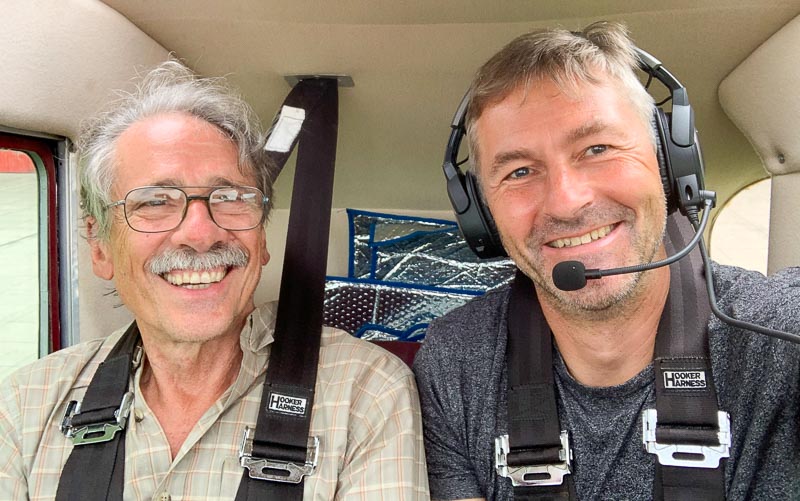
Horacio is a big guy. He has to fold his legs like a yogi, to get into the tiny cockpit. At the Aeroclub Matanza, N5581M is a little sensation, or at least a change of the daily routine of flight training and club life. She is so cute; Carnelia declares, while she pets the airframe. I use the opportunity; give her some polishing paste and wool and she spends the next few hours polishing her new friend. Horacio is an expert; I learn from him. And it is not only me. The flight students and instructors around us learn from him too. After a day of work, my logbook entry reads:
02/26/2022 Tach time: 598.9 hours. SMOH 1240.9 hours. STOH 355.9 hours. Compressions #1 78/80 #2 78/80 #3 76/80 #4 78/80. Changed oil (5 qts Aeroshell W100 Plus) and filter. Filter inspected for particles. Valves inspected with borescope. Drained carburetor to check for contaminants. Inspected fuel filter inside carburetor. Spark plugs in good condition, top and bottom cycled. Fuel strainer disassembled and cleaned.
